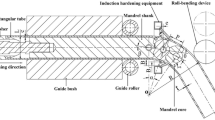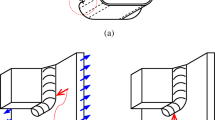Abstract
In regard to light-weight structural members for automobiles, attention to hydroforming has been increasing. Intrusion-bending method is well suited to the preliminary bending of hydroformed structural members of automobiles, because straight tubes can be bent into three-dimensional forms by this new method. However, in the case of tubes with a thin wall thickness, wrinkling remains a problem. In this report, application of intrusion bending method to tubes with extremely low ratios of wall thickness to outer diameter (from 1.2 to 1.9%), and whose steel grades are SSPDX, SAFC440R, and SAFC590T was investigated. A summary of this study is as follows. Effects of steel grades and wall thickness ratios on wrinkle formation, eccentricity, and ovality are studied. Relationships between wrinkle generation and gyro movement are investigated.

















Similar content being viewed by others
Abbreviations
- A :
-
revolution angle of gyro (°)
- B :
-
rotational angle of gyro (°)
- A max :
-
maximum revolution angle of gyro (°)
- B max :
-
maximum rotation angle of gyro (°)
- α:
-
gyro angle ratio (ratio of A-B)
- D :
-
outer diameter of tube before bending (mm)
- D 1 :
-
outer diameter of bent tube along vertical axis (mm)
- D 2 :
-
outer diameter of bent tube along horizontal axis (mm)
- ΔD :
-
(D 2 − D 1) deviation of D 2 and D 1 of bent tube (mm)
- ΔD/D :
-
ovality of outer diameter
- EL:
-
elongation of test specimen
- R :
-
bending radius (mm)
- R/D :
-
bending radius ratio
- t :
-
wall thickness of tube before bending (mm)
- t/D :
-
ratio of wall thickness to outer diameter
- t 1 :
-
wall thickness of bent tube at extrados (mm)
- t 2 :
-
wall thickness of bent tube at intrados (mm)
- Δt :
-
(t 2 − t 1) deviation of t 2 and t 1 of bent tube (mm)
- Δt/t :
-
eccentricity of wall thickness
- TS:
-
tensile strength of test specimen (MPa)
- YS:
-
yield stress of test specimen (MPa)
- x :
-
distance pusher advanced (mm)
References
M. Mizumura, Y. Kuriyama, T. Sugi, M. Fukutoku, and H. Naoi, Effects Manufacturing Conditions on Deformation Behavior of Bent Pipes, Proceedings of the 10th International Symposium on Processing and Fabrication of Advanced Materials, Session 9 Microstructure Property Relationships, November 2001, p 1–13
M. Murata, Y. Uemura, and H. Suzuki, New Penetration Bending of Circular Tube Using Die, J. Jpn. Soc. Technol. Plasticity, 1990, 31(357), p 264–269
OPTON CO., LTD. in Japan, http://www.opton.co.jp Catalog, RP-80-AC of PIPE MULTI BENDER
Author information
Authors and Affiliations
Corresponding author
Additional information
This article was presented at Materials Science & Technology 2007, Automotive and Ground Vehicles symposium held September 16-20, 2007, in Detroit, MI.
Rights and permissions
About this article
Cite this article
Naoi, H., Kitakami, N., Mizumura, M. et al. Study of Intrusion Bending for Steel Tubes with Thin Wall Thickness. J. of Materi Eng and Perform 17, 376–381 (2008). https://doi.org/10.1007/s11665-008-9223-7
Received:
Revised:
Accepted:
Published:
Issue Date:
DOI: https://doi.org/10.1007/s11665-008-9223-7




